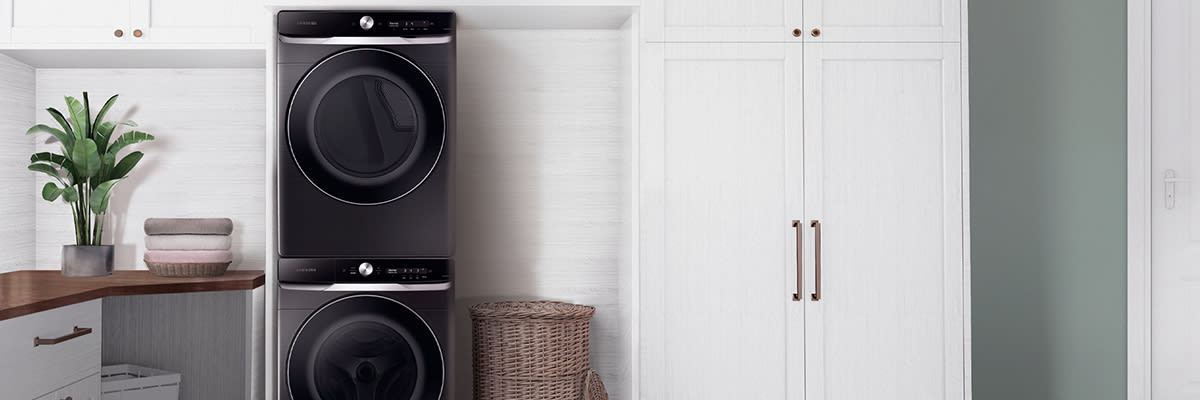
Return navigate_next
Is a Stackable Washer and Dryer Right for Your Home?
April 15, 2022 *
The correct appliances can make all the difference when it comes to the never-ending chore: doing laundry. Washing and drying laundry is a daily task in many households. With that, the right washer and dryer can, quite literally, lighten the load.
For decades, side-by-side top-load appliances have been the go-to solution for many. Today, though, times are changing, and various alternative options are available. From space and convenience to cost and other factors, choosing the ideal washer and dryer combo now involves more careful consideration than ever. So, is a stackable washer and dryer right for you?
What Are the Options?
In the U.S., side-by-side top-load washers and dryers remain the most prevalent. However, households nationwide are increasingly turning to other options. This shift more closely mirrors trends in Europe and elsewhere around the world. Front-load washers and dryers have been the appliances of choice here for decades already.
That’s because many homes in different parts of the world don’t have separate laundry rooms. Instead, they have washers and dryers in kitchens and other spaces. Here, front-load options are more easily integrated into such areas, like under counters or within existing cabinetry.

Placed elsewhere, the same appliances may be stacked. In fact, even where overseas homes do have space for separate laundry rooms, stacked washers and dryers are still routinely more common than side-by-side top-load options. Ultimately, wherever a home is located, several choices are available, including:
- Side-by-side top-load appliances
- Side-by-side front-load appliances
- Stackable front-load appliances
- Stacked top-load washers and front-load dryers
- Combined two-in-one washers and dryers
Countless millions of people also regularly use laundromats. That may be because they have neither a washer or dryer in their home. Alternatively, they may have one or the other and use a laundromat to tackle either the washing or drying aspect of their laundry process. In this instance, it’s quite often the result of a lack of space.
It’s with that in mind that stackable washers and dryers are so useful. When stacked, the two appliances take up the footprint of one. Of course, they do need double the height, so they cannot be installed under counters. Where there’s only space for one appliance, a combined all-in-one machine is another option as well.
However, these commonly involve a compromise in either washing or drying. They can also be prohibitively costly to purchase and both expensive and tricky to troubleshoot or repair if something goes wrong. Accordingly, there’s a strong argument for a separate, stackable washer and dryer setup in many homes.

Stackable Washer and Dryer Benefits
One of the best and easiest ways to weigh up whether a stackable washer and dryer are suitable for your home is by considering the benefits versus the downsides. Perhaps unsurprisingly, there are pros and cons on both sides. First and foremost, though, and among the main pros, are:
- Space-saving layout
- Cost-saving potential
- Easy to mix and match
The space-saving nature of a stackable washer and dryer setup is often its most significant selling point. And the benefits don’t end there, as the front-load appliances most common in this configuration are typically more efficient than their top-load counterparts.
Many are approved by Energy Star, meaning that there’s the potential for significant savings in the cost of electricity or gas, especially in the longer term. It’s also easy to mix and match appliances for a stacked setup, even from different brands. A suitable stacking kit is required, though.
Stackable Washer and Dryer Downsides
At the same time, stackable washer and dryer setups also come with at least a few downsides. For the most part, there are three main cons, which are:
- Purchase cost
- Reduced capacity
- Difficulty when loading
The front-load appliances most commonly seen as a part of stacked washer and dryer installations are invariably more costly than top-load versions. That’s because manufacturers must engineer them more carefully so that they don’t leak from their front-opening doors, for example. The same appliances tend to be slightly smaller by comparison, too, meaning reduced capacity.

Another potential downside that’s easy to overlook is difficulties when loading. That’s versus side-by-side appliances, where moving laundry from a washer to a dryer involves predominantly side-to-side movement. By contrast, moving wet laundry from a washer to a dryer stacked atop may be challenging for some individuals.
Conclusion
So, is a stackable washer and dryer right for your home? Like many things in life, there’s no right or wrong answer. Instead, it’s a matter of weighing up the pros and cons on an individual basis.
That said, when it comes to stacked washers and dryers, the pros invariably outweigh the cons, especially where space is at a premium. Add in the energy-saving potential of a front-load stack, and it’s likely a more cost-effective setup, too.
For maximum efficiency, a matching electric washer and a gas dryer typically form the optimum combination. Therefore, something like the top-rated, best-selling Samsung FlexWash and FlexDry could be perfect.
Protect Your Appliances With Upsie
Whatever you decide, the perfect extended major appliance warranty package is available from Upsie. Upsie’s protection plans offer comprehensive coverage in the event of manufacturing defects, mechanical faults, and other failures. Policies are available for washers, dryers, refrigerators, ovens, and more.
In addition, Upsie customers can rest easy knowing that all of their most important appliances are covered. Other perks include in-home repairs, no service fees, and a $0 deductible on all major appliance warranty claims.
All of Upsie’s extended major appliance warranties are fully transferable, too. A choice of three- and five-year policies are available, and eligibility is open to washers, dryers, and other major appliances purchased in the last 11 months. Find out more at Upsie.com.
Learn More About Appliances:
* This article is over 6 months old and may or may not be updated.
